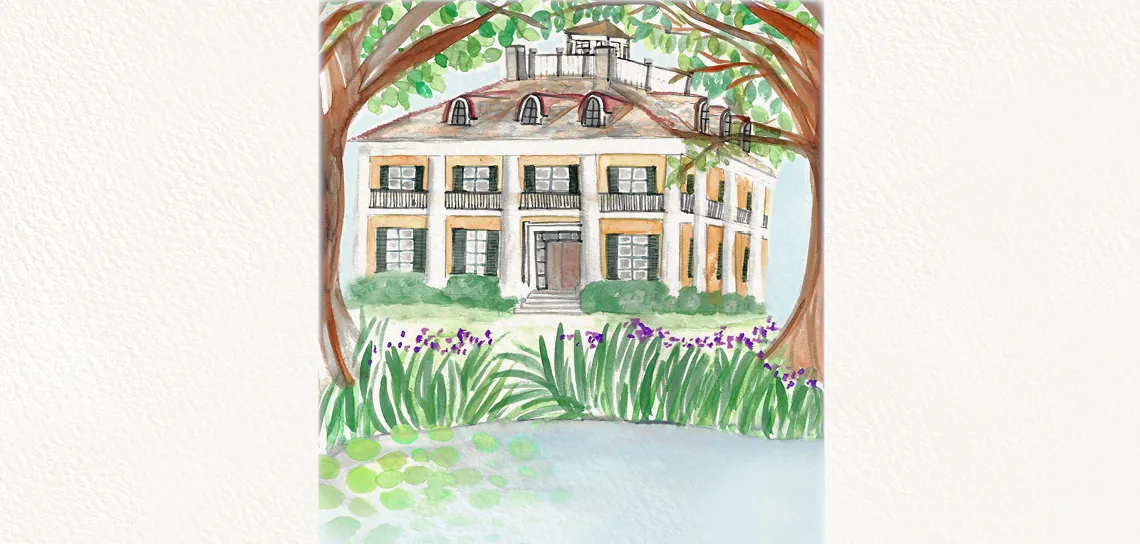Jewels along the Mississippi
Take a trip back in time to a bygone era as you wind down meandering roads next to the banks of the muddy Mississippi River to visit historic homes and landmarks that helped cultivate and influence south Louisiana. These plantation homes, once responsible for driving the state’s sugarcane, indigo and rice industries, now not only serve as spectacular mementos of the immense wealth of Louisiana’s French-Creole and Acadian founding families but also as painful relics of their enslaved people’s bondage, on which the financial success of the estates depended. From White Castle to Garyville, these antebellum mansions feature lush gardens, breathtaking architecture and haunting stories—literally in the case of Houmas House’s spirit child. Many of these plantations offer overnight visits in resort or bed-and-breakfast-style rooms and meals at renowned restaurants and cafes. All are an easy drive from Baton Rouge, with two right within our borders, so be a tourist in your own backyard and visit these jewels along the Mississippi River.
This plantation illustrates the lifestyle of the French Creoles who made the area home beginning in the late 18th century. Operated by BREC, the 16-acre site offers tours, day camps and live demonstrations of daily life at what was once a 900-acre sugarcane plantation. Built in 1791 as a small settler’s home, the main house was later expanded as the property became the seat of a large landowner. Besides the plantation house, visitors can tour a reconstructed open-hearth kitchen, an 1830s-era slave cabin originally located in Pointe Coupee Parish, and the overseer’s home.
Once stretching across 1,200 acres, this antebellum plantation home dating to around 1790 is listed as a National Historic Landmark. Today, the privately owned estate sits on five acres on Highland Road and offers guests the chance to explore a home that once served as a resting place for Confederate soldiers during the Civil War. Its lush gardens, sweeping lawns and 200 year-old legacy oak trees serve as a quintessentially Southern backdrop for weddings, parties and family get-togethers.
Southwest of Baton Rouge stands Nottoway Plantation & Resort in White Castle. The mansion, completed in 1859, is the South’s largest existing antebellum mansion. The home’s Greek and Italianate-style architecture features awe-inspiring white columns, romantic balconies and a three-story rotunda overlooking oak-swept lawns. The 31-acre plantation site has 40 deluxe rooms, including four suites, and more than 15,000 square feet of available rental space plus the Mansion Restaurant. Visitors can learn the history of the home’s original owner, John Hampden Randolph, during daily tours.
Houmas House Plantation and Gardens
Known as the “Crown Jewel of Louisiana’s River Road,” this former sugarcane plantation on 38 acres in Darrow offers a glimpse into the past of a wealthy sugar baron in the 19th century. Guided tours of the Classical Revival mansion include period antiques and Louisiana artwork. Stay overnight at the Inn at Houmas House or dine at one of the estate’s several restaurants. If you’re not afraid of spirits, don’t forget to look for “La Petite Fille,” the ghostly little girl in a blue dress known to walk the halls of the grand home.
Oak Alley Plantation Restaurant & Inn
Twenty-eight distinguished oak trees line the entrance to this grand St. James Parish estate, giving the plantation its unique name. Built in 1837 entirely upon slave labor, the “Big House” was constructed by wealthy sugarcane planter Jacques Roman and today is a National Historic Landmark. The plantation tour includes a slavery exhibit, a Civil War encampment and lush grounds to explore. Visitors can dine at several restaurants or stay the night in modern or historic cottages on the grounds.
This working sugarcane plantation in Vacherie has more than 2,500 acres of farmland with an annual harvest in November. The 12,000-square-foot antebellum plantation was built in 1830 by slave labor and later remodeled by the daughter of a wealthy man known as the “Louis XIV of Louisiana.” In 1877, Joseph Waguespack purchased the home, and today most of his descendants work as tour guides at the plantation. Visitors can tour original slave cabins as well as experience the plantation’s “Mourning Tour” from October through early November where Creole mourning customs and traditions are displayed.
Originally known as “l’Habitation Duparc,” this brilliantly colored sugarcane plantation once totaled 12,000 acres. Construction of the manor house began in 1804 by French naval veteran Guillaume Duparc, whose Creole descendants ran the planation for four generations. It was later renamed “Laura Plantation” after Duparc’s great-granddaughter, Laura Locoul. Today, the grounds and gardens are available for tours, and an exhibit on slavery tells the relationship of Laura’s great-uncle with two enslaved women.
This is the only plantation in Louisiana with an exclusive focus on the lives of enslaved people. The 90-minute guided tour tells the stories of about 350 slaves forced to work on Whitney Plantation, the former grounds of a sugarcane, indigo and rice plantation, over a 100-year period. The tour includes a memorial to honor the more than 100,000 slaves kept in bondage in Louisiana, the plantation’s original slave cabins, outbuildings and the owner’s house dating from the 1790s.
With 37 buildings on the National Register of Historic Places, including 22 slave cabins, Evergreen joins Gettysburg and Mount Vernon in being granted landmark status for its agricultural acreage. Today, it is a privately owned, working sugarcane plantation. The home, a Neoclassical-style house with Federal accents, began as a two-story French Creole home built in the early 1790s. It was remodeled in 1832 and again in 1944 when the home’s beautiful double staircase was added using the original 1832 building contract as a guide. The 90-minute walking tour includes the main house and slave quarters.
Purchased from free man of color Elisée Rillieux in 1830, this home was established as a working sugarcane plantation by Edmond Bozonier Marmillion. Twenty years later, he began a renovation, requesting the unusual, brightly colored decoration of the home’s exterior, hand-painted ceilings and faux marbling and wood. The ornate home is often compared to a colorful Mississippi riverboat by its 100,000 annual visitors. In the late 20th century, the San Francisco Plantation Foundation was created after the home’s purchase by ECOL Company and later Marathon Oil, and a massive restoration of the estate began.
When Pierre D’Trepagnier was awarded a tract of land from the Spanish governor, he built the main home’s central section in 1787 and started an indigo and sugarcane plantation. Located in Destrehan, the house is built in the “Louisiana Colonial” style and modeled after sugar plantations in the West Indies. The home is now privately owned by the Carmouche family, who continue restoration efforts and open it to the public for weddings, tours and bed and breakfast stays.
Once home to Jean Noel Destrehan, who served in the state legislature and U.S. Senate, this St. Charles Parish indigo and sugar plantation was completed in 1790. During the slave revolt of 1811, white residents fled to Destrehan Plantation for safety, and three slaves from Destrehan were executed after the rebellion was quelled. One of the guided tour exhibits sheds light on the revolt, while another displays a document signed by Thomas Jefferson and James Madison appointing Destrehan to a council formed to ease the transition of the area to a democracy.












